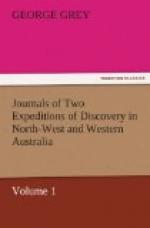Yellow they obtain from several sources: the most common is the yellow clay from which the red is afterwards produced, but they also procure it from a stone which is traversed by veins of yellow earth; from the interior of the nest of a species of ant which collects a yellow dust; and from a sort of fungus from which a similar dust is also obtained.
The black is nothing but finely pounded charcoal.
The white is a very fine greasy species of pipe-clay,
common all over
Australia, and which they use either wet or dry.
How the blue colour used in the caves on the north-west was obtained I do not know; it is very dark and brilliant, and closely resembles the colour obtained from the seed-vessel of a plant very common there, and which, on being broken, yields a few drops of a brilliant blue liquid. I therefore imagined that it was procured from this source.
AGE AND MOTIVE OF DRAWINGS.
With regard to the age of these paintings we had no clue whatever to guide us. It is certain that they may have been very ancient, for, although the colours were composed of such perishable materials, they were all mixed with a resinous gum, insoluble in water, and, no doubt, when thus prepared, they would be capable of resisting, for a long period, the usual atmospheric causes of decay. The painting which appeared to me to have been the longest executed was the one clothed in the long red dress, but I came to this conclusion solely from its state of decay and dilapidation, and these may possibly have misled me very much; but, whatever may have been the age of these paintings, it is scarcely probable that they could have been executed by a self-taught savage. Their origin therefore I think must still be open to conjecture.
But the art and skill with which some of the figures are drawn, and the great effect which has been produced by such simple means, renders it most probable that these paintings must have been executed with the intention of exercising an influence upon the fears and superstitious feelings of the ignorant and barbarous natives: for such a purpose they are indeed well calculated; and I think that an attentive examination of the arrangement of the figures we first discovered, more particularly of that one over the entrance of the cave, will tend considerably to bear out the conclusion I have here advanced.
SINGULARITY REGARDING THEM.
It is a singularity worthy of remark that the drawings we found in the vicinity of the coast were nothing but the rudest scratches; that they gradually improved until we reached the farthest point we attained from the sea; and that it was in the vicinity of this point that some of the best productions were found.
CHAPTER 12. PHYSICAL GEOGRAPHY. COMMERCIAL PROSPECTS.
PHYSICAL GEOGRAPHY. MOUNTAIN RANGES.




